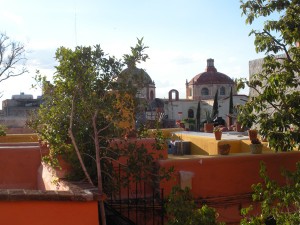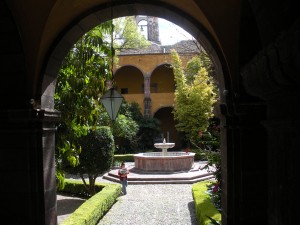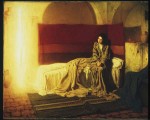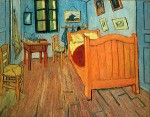Posts from the ‘Painting’ Category
3 Days in San Miguel, part 1.
In the mid 1970s, I spent the fall semester of my junior year of college in San Miguel de Allende, a little town of about 3,000 people, 200 miles west of Mexico City, 6,000 feet up in the mountains.
My school rented a building on Calle Mesones and we had our art classes there. The days were warm, the nights cool. About 20 of my fellow students and I filled our time by making art in the day, debating art late into the evening, drinking the local beer, flirting with the señoritas and walking the town. At nights we’d visit Pan y Vino, Rafaele’s Chicken House or La Fondue, three of several restaurants where, for just a few dollars, you could buy a good meal and a mellow glass of Mexican red.
I remembered San Miguel as beautiful with lush gardens, vivid colors and friendly people. On Sunday evenings in el Jardin, the town square, the young single men and women would circle each other in a mating ritual that was quaint and charming. Elders would sit on surrounding park benches and smile approvingly.
On the feast day of San Miguel, the town turned into Pamplona. The streets were cordoned off; bulls would be turned loose and would run wild chasing down the local men who were crazy enough to test them, and then most of the town would walk the mile or two to the Plaza de Toros. It was like something out of Hemingway. We were treated to three matadors on that particular day; the first two were nothing more than journeymen bullfighters but when the third appeared, it was as if he’d been sent from central casting and San Miguel had suddenly vaulted into the big leagues.
Antonio Lomelin was tall, dark and beautiful to watch, graceful in his movements, fearless in the ring, and magnificent in his suit of lights. He taunted the bull. He commanded the bull. And with his every action, Lomelin whipped the crowd into a frenzy. They chanted a song and called him by name, first from one side of the bull ring and then the other. When it was time for the final dénouement, silence. Lomelin approached, inserted the sword and, with one clean pass through the neck, brought the bull to its knees. The mariachi band burst into song; Lomelin raised his arms in triumph and the crowd rewarded him with both ears and the tail. It was beautiful and horrible to watch, sublime and grotesque at the same time.
I saw things in San Miguel I’ve never seen anywhere else in the world and the memories have stayed with me since. I promised myself I’d go back one day, but as the children grew, as a growing business became more demanding and as tuitions increased exponentially, that promise seemed just like one more left-behind dream.
Jump ahead now 35 years to 2010. I had a business meeting to attend in Cancun and Ann suggested I make a side trip to San Miguel on the way down. I demurred, thinking I couldn’t afford the extra $1,500 it would cost. But then fate intervened and, through a most unusual circumstance, that money dropped into my lap.
I made the reservations with trepidation. My Spanish at one time had been good and in college I could hold my own in a conversation, but as I’d had no reason or occasion to keep my Spanish skills up, I could now only pick out a few words. And the violence and kidnappings that seemed to occur daily in Mexico made me rethink the trip four or five times.
But go I did. And I was surprised by what came next.
To continue this story, read ‘3 Days in San Miguel, part 2.’
Leave a comment
30 Jan 2012
Sliding Doors
- “The Annunciation” by Henry Osawa Tanner
- Bedroom in Arles, by Vincent Van Gogh
I subscribe to Joseph Campbell’s belief that religious institutions often stand in the way of religious experience. I no longer belong to an organized religion but I am keenly interested in spiritual matters.
When I was about 14, I was lying in my father’s hammock in our backyard on a warm day one June, thinking intently on the origins of God. I must have fallen into a trance-like state because for a nanosecond, God became clear to me in a way He had never been before and in that spiritual epiphany, I suddenly understood how She came to be. It was a transcendent moment; it thrilled me beyond any experience I had ever had before (or have had since) but when I became conscious of what I was witnessing, the door closed, the vision disappeared as quickly as one can blink an eye, and I no longer had any recollection of what had been revealed. To this day, I can tell you nothing about that moment other than I had an ‘experience.’
There have been a few times when works of art have elicited a near-supernatural reaction in me. I remember one vividly sometime around 1971 when I was visiting Berkeley, California. I had wandered into the University art museum to see a show of paintings and drawings based on various passages in the Bible. Most of the works were traditional and predictable, until I turned a corner and saw, for the first time, the paintings of Henry Osawa Tanner and, among several works, his depiction of The Annunciation. In this small miracle of an artwork, the Angel Gabriel is represented as a shaft of brilliant light. To me, this painting is a tour de force, certainly because of Tanner’s painterly skills but, more importantly, for his unique, radical and well-ahead-of-anyone’s-time interpretation of a divine being as a beam of concentrated energy. What makes Tanner’s work all the more remarkable was his time period (1859-1937) and his race. Tanner was black and living in post-Civil War America. Perhaps he wanted to shake up the white art establishment. I like to think, however, that Tanner, himself, was divinely inspired to create this particular Gabriel. I looked at that painting for 30 minutes. When I finally walked away I thought, ‘Tanner got it perfectly right.’
I had another metaphysical moment just a few years ago, although it didn’t involve a divinity. It was more like an out-of-body-experience. I was at the Getty Center standing in front of Van Gogh’s, Bedroom in Arles, when I felt teleported inside the painting through some kind of time-shifting, altered-state experience. For a second or two, I found myself standing at the foot of that bed in that very room Van Gogh had painted. When I told a few people later about my experience, I laughed it off by blaming the funny mushrooms I must have had the night before in my Veal Piccatta, but it was a real and disorienting feeling. I can’t explain it.
I’ve had a few other metaphysical experiences and I’m sure there are many others who have had similar extra-dimensional moments. Perhaps they are attempts by the spiritual to reconnect with the physical or they’re worm holes in time and matter that allow us to peek into an alternative universe. Or perhaps they are merely delusions. I don’t pretend to know what they mean. But every chance I get, I have the Veal Piccatta and hope for another glimpse into what I don’t understand.
14 Jan 2012
My Studio
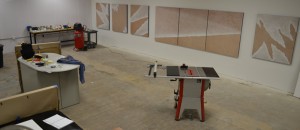 My art studio is located deep in the bowels of south St. Louis. It’s a dodgy part of town and, from the outside, the building where my studio is located looks like a place where serial killers would come to cut up their victims. But inside, the space is very nice.
My art studio is located deep in the bowels of south St. Louis. It’s a dodgy part of town and, from the outside, the building where my studio is located looks like a place where serial killers would come to cut up their victims. But inside, the space is very nice.
I have 1,500 square feet of bright white work area, 12′ high ceilings, and lots of amenities like enough power outlets for a small city, a big electrical box so we never lose juice, and a peg board that can hold all the tools in a Home Depot.
Tim is the guy who owns the building. He’s an engineer. I like having an engineer own the building rather than an artist, accountant, lawyer or insurance agent. When things go wrong in a building, you want a guy who knows how to do stuff, not a guy who makes his living running income statements. Engineers know how to do stuff and because they’re engineers, they usually over-engineer a solution so the problem is fixed for the next millenium. This is Tim’s first foray into building ownership and management. I’m his first tenant.
My former studio was located on a third-floor walkup in an old brewery. Every time I stepped into the building I’d get a flashback to when I lived in New York City in the mid-70s. My studio then was close to Bedford-Stuyvesant, which at that time was the 2nd worst neighborhood in America. You’d practically need combat pay just to get in and out of the place.
My brewery studio had wonderful light, but the windows were loose in their frames and the building was drafty. The owners seldom turned on the heat in the winter and there was no air conditioning in the summer, so for half or more of each year, I’d either be shaking or sweating. But the street had large, mature trees. There was a friendly bar just outside, a shop that sold pies a few doors down, several antique stores, and the local coffee house two blocks away was grand. They had a small reading library so, if you wanted to, you could buy a cheap lunch, find a warm spot and read Elmore Leonard all afternoon.
I stuck it out for about 15 months at the old studio, but when winter came the second time around, I just couldn’t take the cold any more. So I flew south about 8 blocks to greener pastures and central heating.
If you’re in the neighborhood, stop in and have a cool drink from the community water fountain. I’ll play some jazzy tunes from the ipod and we can snap our fingers and call each other ‘man,’ just like artists are supposed to do. And depending on how I feel that day, I may even put on a beret.
29 Dec 2011
